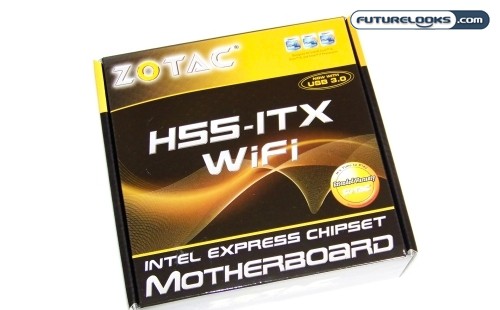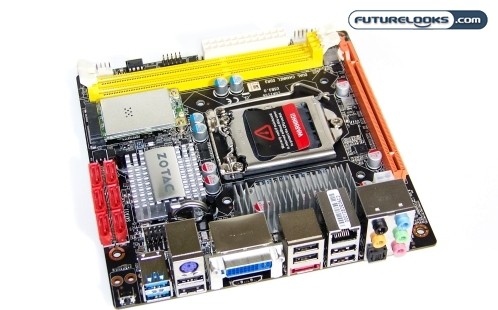
Enthusiasts love to show off their biggest, most powerful computers. While visiting Texas for a little QuakeCon action, I saw some crazy huge computer systems taking up a little bit more than their share of the table, or even the actual walk ways. In the eyes of many gamers and enthusiasts, bigger often means better and faster. ZOTAC, who is the trailblazer in Mini-ITX motherboards, think that shrinking the size of a platform and giving it scalable options, is the way to go. With the right mix of components, could the ZOTAC H55-ITX-C-E could be your next “big” system? Let’s find out!
Features and Specifications
Before we jump into a bit more discussion, here’s a quick video overview of the board and what you get with it:
While previous generations featured integrated single and dual core ION processors, the H55ITX-C-E is much like any other Micro-ATX and ATX motherboard. It supports Core i5 and i7-800 series LGA1156 processors, 1333MHz DDR3 memory, and even a full speed x16 PCI Express slot . To support the Core i5 processors with integrated HD graphics, the motherboard has DVI and HDMI ports. These are the two common ports associated with monitors these days. Otherwise, you’ll find a VGA-DVI adapter in the box.
You’ll be happy to know that the H55ITX-C-E supports Intel Turbo Technology which wasn’t available in early models. That should give the LGA1156 processors a nice extra boost when needed. Other features include USB 3.0, SATA 3, and eSATA ports. And, of course, 8 channel Realtek HD audio with supporting SPDIF and analog jacks.

The Mini-PCIE Express slot comes with a WiFi card installed supporting 80211n speeds. However, users will have to connect the antennae unit themselves which is easy enough. Still, this saves you a little cash and opens up the ITX system to more possibilities.
All of these features can be had for about $139.99 compared to the average $159.99 price tag of a good quality, regular ATX based motherboard. Keep in mind that the H55ITX features wireless-N where as you’ll need to add a wireless adapter to the price tag of any motherboard. So, there’s value here even if you don’t see it at first.
Test System and Notes
I didn’t get anymore creative than usual when testing the ZOTAC H55ITX-C-E motherboard. Since it’s very similar to regular motherboards only a lot smaller, it’s standard business as usual. I decided to use some upscale components to show you what can be achieved with a little patience and finger dexterity.
- Processor: Intel Core i5-655K Lynnfield LGA1156 Processor
- Motherboard: ZOTAC H55ITX-C-E (as tested)
- Motherboard 2: GIGABYTE GA-H55M-USB3 (for comparison)
- Memory: Kingston HyperX LOVO 4GB 1866MHz DDR3 Dual Channel
- Graphics: ZOTAC Geforce GTX480 Video Card
- Storage: Kingston 128GB V+ SSDNow (Rev 2.0)
- Storage 2: Rosewill USB 3.0 Enclosure w/Seagate Barracuda XT 2TB Hard Drive
- Case & Power Supply: Silverstone SG-07 w/SST-ST60F-SG (600 watt)
- Operating System: Windows 7 Professional
Since the ZOTAC board supports wireless 802.11n protocol and the ASUS does not, I only gave the feature a spin rather than an all out benchmark. However, data transfers were very comparable to two wireless-N capable laptops in the office. On with the benchmarks!
Benchmark Notes
The following applications were used in testing and benchmarks: PCMark Vantage, CineBench 11.5, Graysky’s H.264 Encoding, Unigine Heaven v2.1 Demo, Alien vs Predator DX11, and Battlefield Bad Company 2.
PCMark Vantage
Don’t let the size of the H55ITX-C-E fool you. As far as PCMark is concerned, it’s a full sized platform. I reran the benchmarks more than twice to see if the scores were a fluke.
CineBench R11.5
The story is just a tad different here. Cinebench favored the micro-ATX platform, but just by a small minimal .02 or so. Several different factors can effect the results. The USB3 board tends to run just ever so slightly faster in the BIOS automatically even when forced to do certain settings.
GraySky H.264 Encoding
After a little encoding dust settled, both platforms were very close. If you’re wondering why these scores are lower than a Core i5-750 or better, it’s because the Core i5-650K has a slower integrated memory controller. Fortunately, the extra Hyper Threads do a great job of helping out the assignment.
Unigine Heaven v2.1
Still one of my favorite free to download benchmarks, Heaven Demo V2.0 gives the system something beefy to chew on graphic and CPU wise. At 1920 x 1200 2AA and 4AN, the H55ITX was a hair more aggressive finishing off the benchmark.
Alien vs. Predator (DX11)
The AVP benchmark, also free to download, is a pretty graphic intensive 3D benchmark. It’s sole purpose is make any video like our GTX480 cry. This time, frame rates were extremely close. Nothing to do but keep going.
Crysis Warhead & Battlefield Bad Company 2
Again, the H55ITX and USB3 fought very closely. I wouldn’t say either out did the other when it came to 3D applications. Both would make a great gaming system. The H55ITX is just a much smaller fighter is all.
Now let’s move on to the IO and functionality tests and bring this review home.
Input/Output: USB and SATA
Bandwidth and frequencies favor the path of least resistance. Here, the smaller ITX board seems to benefit both in USB and SATA performance. Of course, unliked the USB3< SATA3 performance really hasn’t produced any real jaw dropping performance differences with today’s standard components.
Wireless 802.11n
I compared the wireless throughput couple different 802.11n wireless devices to the AsureWave mini-PCIE device that comes installed by ZOTAC. The Realtek (8191SE) and DLink wireless adapters are two typically found in capable laptops. ZOTAC’s solution is noticeably faster and will handle 1080p streaming.
RightMark Audio Analyzer
RMAA has been pretty instrumental in detecting the very small variances that normally effect integrated audio processors found on today’s motherboards. Tests revealed that the m-ITX platform offers audio quality somewhere between that of budget notebooks and regular ATX boards.
When testing the board at typical 16/24-bit at 48Hz, THD (Total Harmonic Distortion) was a little higher than I’m accustomed. But, the platform actually produces better audio quality at 24-bit at 92 and 192Hz. The bottom line here is that chances are you won’t ever notice and that it’s got something extra up top, especially if you use the SPDIF (optical) out cable instead.
Final Thoughts
It might be really small, but it can obviously keep up with any ordinary full sized system. It doesn’t come up short when it comes to onboard IO expansion options either. There’s enough USB and SATA to go around. Plus, this the only ITX solution on the market that integrates ZOTAC’s signature WiFi option. Granted, it doesn’t offer SATA3 expansion. But, 6Gb/s hard drives haven’t offered the same kind of performance increases that cheaper USB 3.0 offers.
The ZOTAC H55ITX-C-E can do just about anything because it’s completely scalable, meaning users can use any choice of Intel Core i5/i7 processor, DDR3 memory, and PCI Express 2.0 video card. While this test system was a bit overkill, it doesn’t take much to create your own flawless HTPC to end all HTPCs, or even a kick a$$ gaming system. Ultimately, this SFF motherboard dares to stand against the larger ATX and mATX variants.
The best about this board is pricing. With the onslaught of Sandy Bridge boards driving down prices of previous P55 parts, the ZOTAC should be seeing some mark downs making it a great choice for people looking to snap up a deal on one of the finest mini-ITX boards out there to date.
Pros
- Small ITX form factor
- Great expansion and scalability
- Excellent Wireless 802.11n adapter onboard
- Full 7.1 channel HD integrated audio
- Intel Turbo Technology supported
Cons
- Case selection is important for max performance components
Overall Rating: 9.0 / 10.0
Love This Review? Hate This Review? Leave a Comment or Hit The Forums!
ZOTAC H55ITX-C-E Mini-ITX Motherboard Review – Photo Gallery

